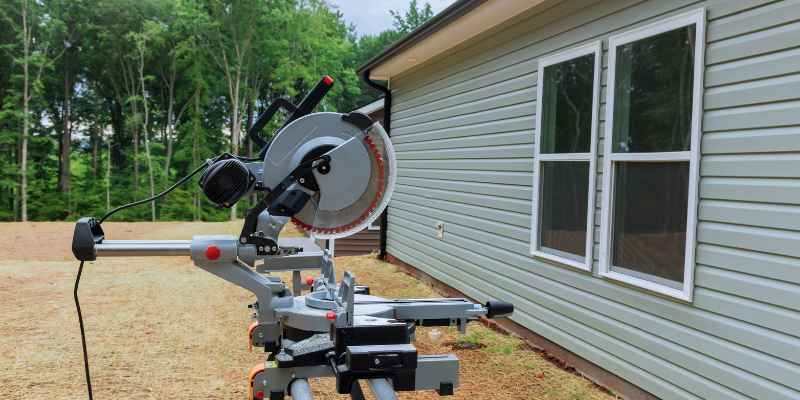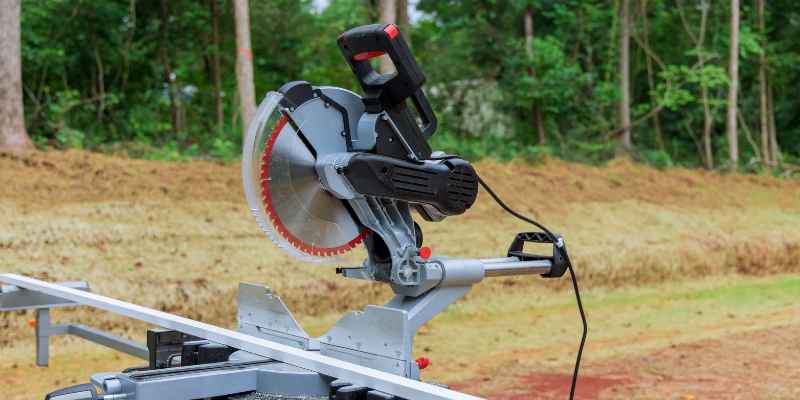Critical differences exist between a 10″ miter saw and a 12″ miter saw. The size of the blade is the most obvious difference, with the 10″ having a minor edge than the 12″. This means that the 10″ can make narrower cuts but also has a lower cutting capacity.
The 12″ can handle more significant pieces of wood and make broader cuts. Another difference is in the motor size – the 12″ typically has a larger motor, giving it more power and better suited for heavy-duty use.
There are a few key differences between 10″ and 12″ miter saws that you should consider before making a purchase. The most apparent difference is blade size – a 12″ blade can make broader cuts than a 10″ blade. Additionally, 12″ miter saws typically have more powerful motors than their 10″ counterparts, meaning they can handle tougher cuts.
Finally, 12″ miter saws usually have longer arms, giving you more reach for those more significant cuts. So which one is right for you? It depends on the types of projects you’ll be working on. If you’re mostly doing smaller jobs, then a 10″ miter saw will probably suffice. But if you’re planning on tackling some more significant projects, or if you value power and reach over portability, then a 12″ miter saw is the way to go.

10 Inch Vs. 12 Inch Miter Saw Reddit
When choosing a miter or saw, one of the most important decisions you’ll make is deciding between a 10-inch and 12-inch model. You’ll need to consider both pros and cons before making your final decision.
Here’s a quick rundown of what you need to know about each option:
10-Inch Miter Saw Pros:
– More affordable than 12-inch models
– Lighter and easier to transport
– Takes up less space in your workshop
10-Inch Miter Saw Cons:
– Limited cutting capacity compared to 12-inch models
10″ Or 12 Inch Miter Saw Forum
In the world of woodworking, there is a great debate about which size miter saw is better for the job, 10″ or 12″? Both have their pros and cons that woodworkers argue over to this day. In this blog post, we will explore both sizes in detail so that you can decide which would be better for your woodworking projects.
The 10″ miter saw is a versatile tool that can be used for various projects. One of the main benefits of using a 10″ miter saw is that it is much easier to handle and maneuver than its larger counterpart. This makes it ideal for smaller projects or those just starting in woodworking.
Another benefit of the 10″ miter saw is that it is less expensive than the 12″ version, making it more budget-friendly. However, there are also some drawbacks to using a 10″ miter saw. One of the biggest problems is that making precise cuts with this size saw can be challenging.
This is because the blade isn’t as large, so there is less room for error. Additionally, the minor edge can cause the saw to vibrate more, leading to fatigue if you are working on a large project. The 12″ miter saw solves many of the problems associated with its smaller counterpart.
The larger blade provides more stability and allows for more precision when cutting. Additionally, the 12″ miter saw’s increased weight helps reduce vibration, making it easier on your hands and arms during extended use. However, all these benefits come at a cost – literally!
Bosch 10 Vs 12 Miter Saw
Regarding miter saws, two of the most popular brands on the market are Bosch and Dewalt. Both brands offer a variety of models to choose from, so it cannot be easy to decide which one is right for you. In this blog post, we’ll compare two of Bosch’s most popular miter saws – the 10-inch and 12-inch models – to help you decide which is best for your needs.
The first thing to consider when choosing a miter saw is the size of the blade. The Bosch 10-inch model has a more minor edge than the 12-inch model, which means that it can make narrower cuts. If you’re looking for a saw that can handle larger pieces of wood, then the 12-inch model would be a better choice.
However, if you’re only making cuts in small pieces of wood, then the 10-inch model would suffice. Another thing to consider is the motor power. Both Bosch models have powerful motors that can handle heavy use, but the 12-inch model has a slightly more powerful engine than the 10-inch model.
This means that it can make faster and smoother cuts through thicker materials. If you need a saw that can handle large projects quickly and efficiently, then the 12-inch model would be a better choice. However, if you only need a saw for occasional use or light-duty projects, then either model would work well for you.
Finally, take into consideration your budget when choosing between these two models. The Bosch 10-inch model is less expensive than the 12-inch model but still offers features that make it an excellent value for its price range. If cost is an essential factor in your decision-making process, then the 10-inch model may be a better option.
10″ Sliding Compound Miter Saw
When making precise cuts, a 10″ sliding compound miter saw is hard to beat. This type of saw is ideal for trim work, molding, and framing projects. Here’s what you need to know about using a 10″ sliding compound miter saw.
The first thing to remember is that a 10″ sliding compound miter saw requires more power than a standard circular saw. As such, you’ll need to ensure the saw is correctly plugged into an outlet before using it. Additionally, you’ll want to wear safety goggles and gloves when operating the saw.
To use the saw, start by aligning the blade with the mark on the wood where you want to make your cut. Then, hold down the trigger and slowly lower the edge into the wood. Once the border has reached its full depth, release the trigger and let it return to its starting position.
Repeat this process until you’ve made your desired number of cuts. Remember that a 10″ sliding compound miter saw can be dangerous if not used properly. Always exercise caution when operating any power tool.
Best 10 in Sliding Miter Saw
When it comes to a miter or saw, there are many options on the market. If you’re looking for the best of the best, check out the top 10 sliding miter saws. These saws are designed for precision and power and can make quick work of any project.
The first thing you’ll notice about these saws is that they’re built with quality in mind. They feature heavy-duty construction and powerful motors that can handle even the most brutal cuts. Plus, they come with various features that make them easy to use and versatile enough for any job.
One of the essential features to look for in a miter saw is adjustable bevel settings. This allows you to make precise cuts at any angle, which is necessary for trim work or molding projects. And speaking of molding, many of these saws also come with built-in Crown Molding Stops that make it easy to get perfect results every time.
Another great feature is dust collection. Some models come with vacuum attachments that collect up to 90% of the dust created while cutting. This keeps your workspace clean and helps prolong the life of your saw by keeping the internal components free from debris build-up.
Finally, consider ease of use when choosing a miter saw. Look for models with large cutting capacities and comfortable handles that make it easy to maneuver around your workpiece.
Best 10-Inch Miter Saw
If you’re in the market for a 10-inch miter, saw, there are a few things you’ll want to keep in mind. First, decide whether you want a corded or cordless model. Corded models offer more power and torque, while cordless models offer portability and convenience.
Next, consider the features that are important to you. Some saws have built-in dust collection systems, laser guides, and LED work lights. These features can be helpful, but they’ll also add to the cost of the saw.
Finally, take a look at the blade options. Some 10-inch miter saws come with 60-tooth blades ideal for cutting softwoods like pine and fir. Others have 80-tooth edges better suited for cutting hardwoods like oak and maple.
Choose the blade that best fits your needs. Once you’ve considered these factors, it’s time to choose the best 10-inch miter saw for your needs.
12-Inch Miter Saw Cut Capacity
Assuming you are referring to a 12″ miter saw, the capacity would be defined by the size of the blade that it uses. The most common blade size for a 12″ miter saw is 10″. This means that the maximum cut capacity for a 10″ blade is 2-1/2″ x 12″. Of course, different blades can be used with a 12″ miter saw. For example, if you were to use an 8″ knife, the maximum cut capacity would be reduced to 2″ x 8″. It’s important to note that the size of the blade you use will also affect the kerf of your cuts.
A wider blade (like a 10″) will have a wider kerf than a narrower blade (like an 8″). When making precision cuts, it’s often best to use a thinner blade.
Can You Put a 10-Inch Blade on a 12-Inch Miter Saw?
If you’re looking to make quick, precise cuts, a miter saw is a tool for the job. Miter saws come in a variety of sizes, with the most common being 10-inch and 12-inch models. So, can you put a 10-inch blade on a 12-inch miter saw?
The answer is yes! You can safely use a 10-inch blade on a 12-inch miter saw. Many people find that using smaller blades results in cleaner, more precise cuts.
However, a few things to remember when using a trimmer blade on a larger miter saw. First, you’ll need to adjust the depth of the cut so that the edge doesn’t protrude too far from the baseplate. Second, be sure to use an appropriate Blade Guard system for your miter saw model.
Overall, using a 10-inch blade on a 12-inch miter saw is safe and can help you achieve better cutting results. Always take the necessary precautions and follow the manufacturer’s instructions when adjusting your tools.
Is 10 Or 12 Miter Saw Better?
If you’re looking for a miter saw that can handle big projects, then the 10″ or 12″ models are your best bet. These saws can make precision cuts in thick materials, and they have the power to handle more demanding jobs. Of course, there are trade-offs to consider.
A bigger miter saw will be more expensive and harder to maneuver. So it’s essential to choose the right size saw for your needs.
What Size Wood Can a 10-Inch Miter Saw Cut?
When it comes to woodworking, a miter saw is an essential tool. It’s often used to make precise cuts for molding, trim work, and framing. But what size of the wood can a 10-inch miter saw amount?
The answer may surprise you. While most 10-inch miter saws are designed for cutting smaller pieces of wood, some models have the power and blade size to handle more significant cuts. In general, a 10-inch miter saw is best suited for cutting boards up to 6 inches wide.
So if you’re working on a project requiring precision cuts in larger pieces of wood, you may consider upgrading to a 12- or 14-inch model. Otherwise, a 10-inch miter saw should be able to handle just about anything you throw at it.
Can a 10 Mitre Saw Cut a 4X4?
A miter saw is used to make precise cuts at various angles. The most common use for a miter saw is to cut molding or trim for use in construction or home improvement projects. A 10-miter saw can cut a 4×4, but it depends on the blade used.
If you use a standard blade, the answer is no – the edge isn’t long enough. However, if you’re using an extended edge, a 10-meter saw can cut through a 4×4 with ease.

Will a 10 Sliding Miter Saw Cut a 2X12?
To answer this question, we must first understand what a miter saw is and what it is used for. A miter saw is used to make precise cuts at various angles. The most common use for a miter saw is cutting trim or molding.
However, they can also cut other materials, such as wood, metal, and plastic. Now that we know what a miter saw is and what it does, let’s answer the question. Will a ten sliding miter saw cut a 2×12?
The answer is yes! A 10-sliding miter saw can handle cutting a 2×12 piece of lumber. Most 10″ miter saws are designed to cut lumber up to 6″ wide.
So not only will your 10″ miter saw have no problem cutting through a 2×12, but it will also have no problem making precision cuts on any other type of material you may need it for.
Conclusion
If you’re in the market for a miter or saw, you may be wondering whether to get a 10″ or 12″ model. Both have pros and cons, so it’s important to know what you need before purchasing. A 10″ miter saw is smaller and more lightweight than a 12″, making it easier to transport and maneuver.
It also has a smaller blade, which means it can make narrower cuts. However, its small size also means that it doesn’t have as much power as a 12″, so it’s not ideal for large projects. A 12″ miter saw is larger and heavier than a 10″, but its extra size gives it more power and allows it to make broader cuts.
It’s also better suited for large projects. However, its size can make it more difficult to transport and maneuver. So, which one should you choose?
It depends on what you need it for. If you’re only going to be using it for small projects or making narrow cuts, then a 10″ miter saw is probably all you need. But if you’re planning on tackling larger projects or making broader cuts, then a 12″ model would be better suited for your needs.



2 thoughts on “Which Miter Saw Is Best For You? A Detailed Comparison Of 10 Miter Saw Vs 12”